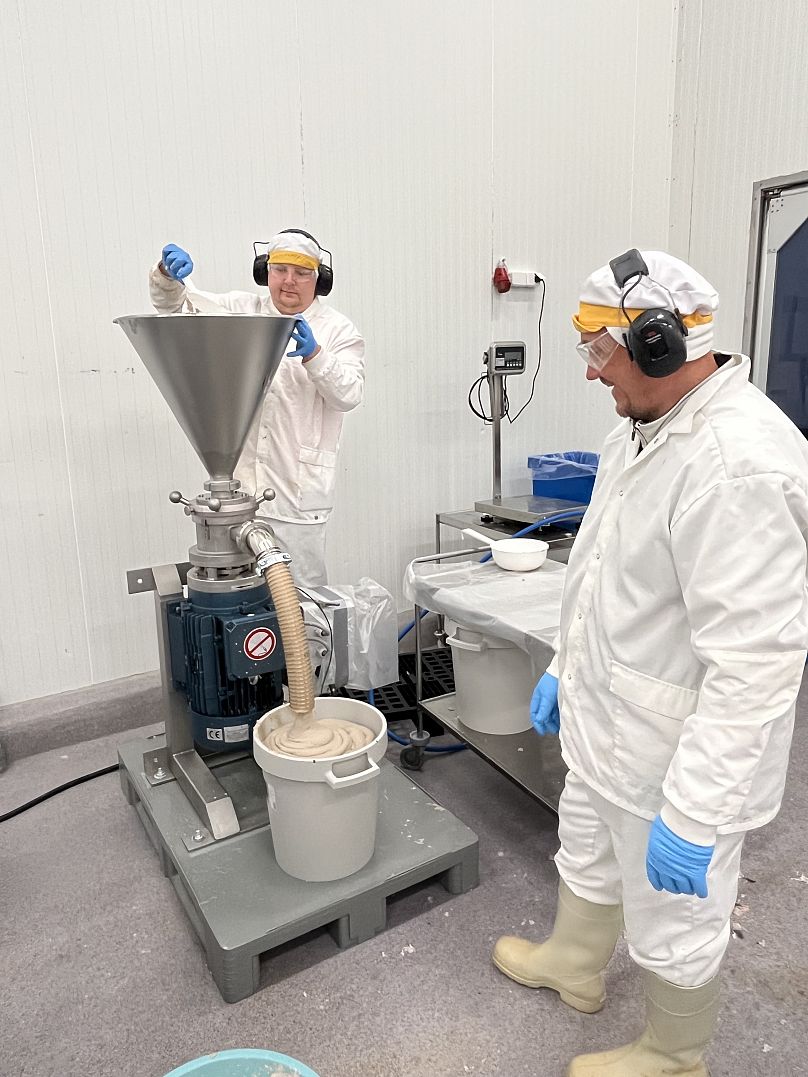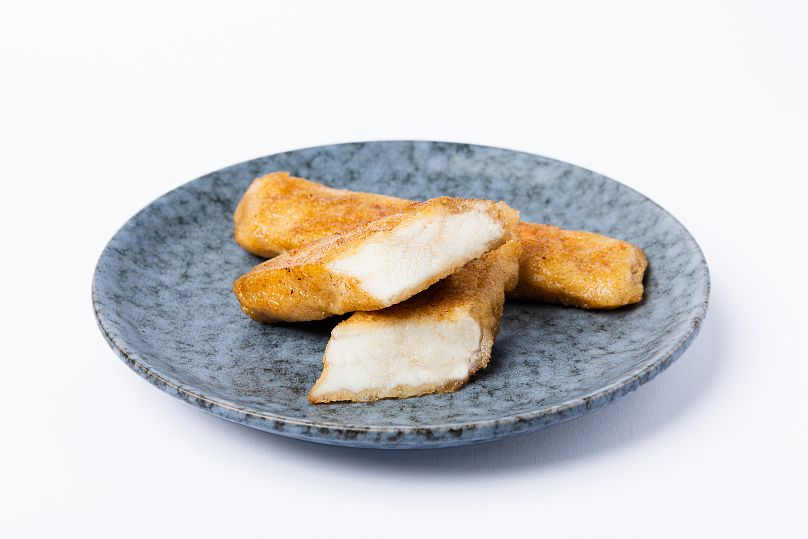Food scientists have found a way to make chicken nuggets and fish cakes out of otherwise discarded bones and hard tissues.
It might sound like the premise for a third ‘Chicken Run’ movie, but there are good environmental reasons behind the solution from Finnish startup SuperGround.
The idea is to reduce food waste and carbon emissions from animal agriculture, by getting more mileage out of the meat, thereby requiring fewer animals to be farmed for the same output.
“I have been collecting a list of unsolved food related problems for many years,” SuperGround founder and chief inventor Santtu Vekkeli tells Euronews Green. “Utilisation of bones to food without chemicals such as enzymes was on the list for maybe eight years.”
Combining and tweaking a number of existing machines, the inventors served up a “smooth and tasty paste” from hard tissues for the first time three years ago. SuperGround is now looking to partner up with global food production companies enthused by its sustainable mission.
Keen to take a bite? Here’s what you need to know.
How can bones be used in food?
SuperGround’s method leaves most of the nutrients in the meat - like heat-sensitive vitamins - in a usable, non-denatured form. Another USP is that the resulting paste is easy to mix with existing muscle-based food products such as fish cakes and chicken nuggets.
“Hard tissues are great material for food and have approximately the same amount of protein and fat as minced meat,” says Vekkeli.
Up to 30 per cent of a nugget can be made from paste-ified leg, breast, back bones and wing tips, without compromising its taste, smell and other characteristics like ‘biting resistance’.
This figure is lower than for fish, in which the inventors say they have successfully swapped in up to 50 per cent of the mass from raw materials such as fish heads, skin, scales and bones.
Vekkeli explains this is because people have a more precise image of what nuggets should taste like compared to fish balls, for example. And fish products tend to be softer.
“The highest percentage without changes in sensory properties can be used in chicken kebab and salmon balls in fish items,” he adds.
For both chicken and fish products SuperGround claims its process can cut CO2 by increasing the food yield by 20 to 70 per cent.
“CO2 emissions will decrease only in the scenario where [the] consumption of animal products does not increase more than our solution increases the available amount of food,” Vekkeli says.
What happens to bones and animal waste currently?
As chicken turns to poultry, and cows to beef, their ‘off cuts’ tend to go out of sight and mind. But a huge amount of waste is produced from animal agriculture.
More than 130 million tonnes of poultry meat is consumed a year, according to Statista data. Around 20 per cent of poultry’s mass is hard tissue, says Vekkeli, making “the scale of [this] issue huge.”
“Normally bones are cooked to broths or fractioned to separate protein, fat and other fractions if processed to food. Most of the bones are rendered back to a feed chain and just disposed [of] to landfill,” Vekkeli adds.
Agricultural economists are more conservative in their assessment. “Based on what I know from the produce industry, I would expect that waste is managed and re-purposed very efficiently,” says Brenna Daun Ellison, associate professor in Agricultural Economics at Purdue University.
“I would expect the most common repurposing would be for animal feed, biofuel, cosmetics, etc.”
In the EU, chicken bones are exported for use in pet food or to feed livestock. Since 2021, the bloc relaxed rules so that processed animal protein (PAP) from chickens, including bones, could be fed to pigs - and vice versa.
Can eating bones make a big dent in emissions?
“Say hello to a world where sustainable meat is no longer a paradox,” SuperGround’s website declares.
Food systems are responsible for a third of all planet-heating gases, with the use of animals for meat causing twice the pollution of plant-based foods.
“[The] modern animal-based food system is obviously not the optimal way to produce food for the global population,” Vekkeli says over email, “but it is the system we have now.
“People (and the industry) are used to it and it takes a long time to improve (but climate needs actions immediately!). We need positive changes now and the most efficient way to improve it is to do something that does not need changes in the purchase pattern of ‘average’ customers,” he says.
Ground chicken products make up a relatively small slice of the overall meat market, Jayson Lusk - vice president and dean of Oklahoma State University’s Agricultural Sciences and Natural Resources - previously pointed out to Wired.
So it’s unlikely that filling out chicken nuggets with bone will suddenly make meat sustainable. But it’s “an interesting concept” says Ellison, in an industry that urgently needs to change.
Will consumers take to it?
Humans are having to get more expansive in our food choices - with everything from deep-fried insects to lab-grown burgers appearing on the menu.
Could carnivores be persuaded to consume more of a carcass?
“We have learned that people don’t want to have taste, mouth feel or smell changes in their products,” says Vekkeli. “Recipe changes are normal practice and people accept them as long as the products have the same sensory and nutritional characteristics.”
Potentially, food producers may be tempted by the efficiency and cost savings first, championing bone-filled meat for their consumers.
The ‘Upcycled Certified Program’ - a means of regulating food by-products in the US - could be one example of how to market the meat, Ellison suggests.














